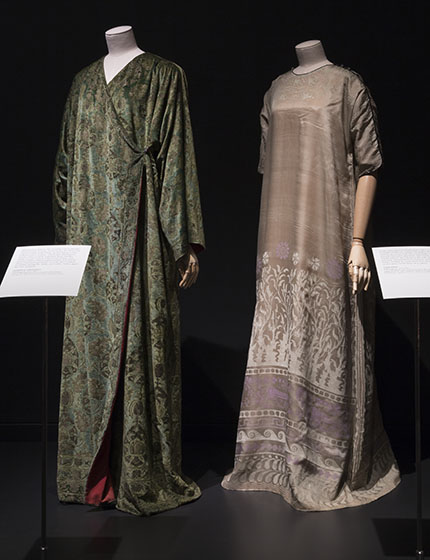
Photograph © Zach Hilty/BFA.com
Far left: Attributed to Babani, this evening coat is strongly influenced by Fortuny. In particular, the floral and vegetal motifs of the fabric recall Fortuny’s love of Renaissance textiles, which were themselves heavily influenced by imported Asian textiles. Made of green velvet, lined in red taffeta, and fastened with a Murano glass button, it is one of many Orientalist garments worn by the Countess Greffulhe during the 1910s and 1920s. Notice again her love of green.
Attributed to Vitaldi Babani
Evening coat, circa 1912
Green silk velvet printed with gold, glass buttons
GAL1964.20.13, gift of the Gramont family to the Palais Galliera
Evening coat, circa 1912
Green silk velvet printed with gold, glass buttons
GAL1964.20.13, gift of the Gramont family to the Palais Galliera
Near Left: In the years prior to World War I, the Countess Greffulhe began to support the Ballets Russes, and her personal style also increasingly gravitated toward Orientalist garments. The house of Vitaldi Babani specialized in the sale of Japanese kimonos and garments by Fortuny and Liberty, before starting to create their own designs, such as this gown in the form of a caftan, which was originally worn, slightly bloused, over a sash.
Vitaldi Babani
Indoor gown, circa 1912
Grey silk taffeta with painted pochoir decoration, silk passementerie, glass buttons, lined in orange silk taffeta
GAL1964.20.12, gift of the Gramont family to the Palais Galliera
Indoor gown, circa 1912
Grey silk taffeta with painted pochoir decoration, silk passementerie, glass buttons, lined in orange silk taffeta
GAL1964.20.12, gift of the Gramont family to the Palais Galliera
Proust’s Muse, The Countess Greffulhe runs through January 7, 2016 at The Museum at FIT in NYC.




 Mariano Fortuny
Mariano Fortuny